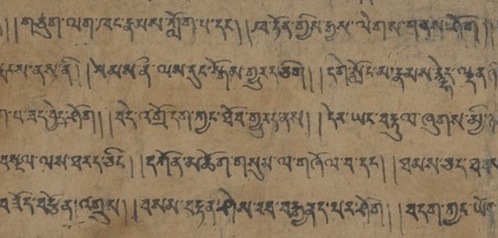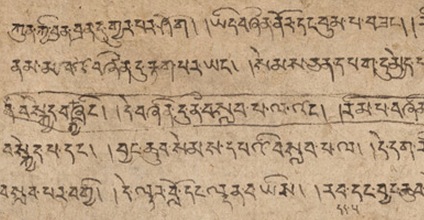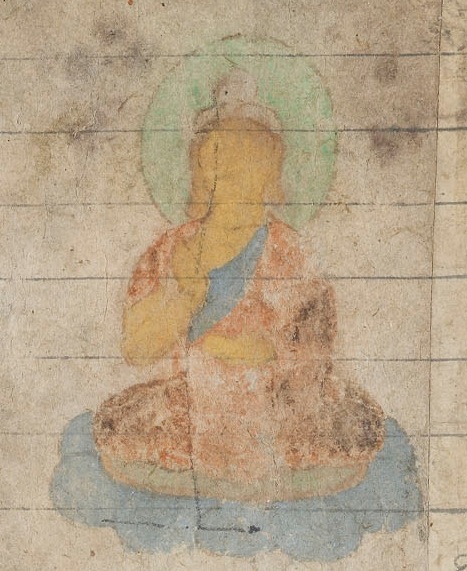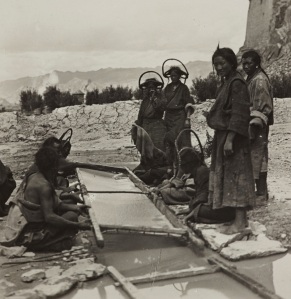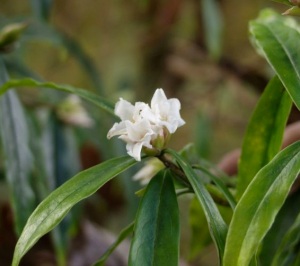Phrasebooks still seem to sell quite well, judging by their presence on bookshop shelves. If translation apps do eventually make them redundant, it will be the end of a tradition that goes back a long way. The Central Asian manuscript collections provide plenty of evidence that phrasebooks were popular with travellers on the Silk Road in the first millennium AD.
One Tibetan-Chinese phrasebook (found in Or.8210/S.1000 and S.2736) was obviously compiled for merchants. The phrasebook gives the Tibetan word, followed by the Chinese equivalent, all in the Tibetan script. Thus it was clearly written for travellers who knew the Tibetan language but little or nothing of Chinese. In this phrasebook, the names of goods including food, clothes, tools, weapons and armour predominate.
 Also here are words and phrases helpful to visitors to a strange town looking for food and a bed for night, and moving on to the next destination. The phrasebook is also there for travellers who encounter problems such as illness, being robbed, or being accused of being a thief, including the essential (but perhaps not very effective) “what have I done wrong!?” Probably more useful is the translation of the title of the Tibetan emperor and other high officials in the Tibetan empire. There is also a Chinese translation of the word bonpo, in case you need the help of a ritual specialist. The author of the phrasebook had a sense of humour: the last phrase he included is “shut up!” Sometimes even an intrepid traveller needs a bit of peace and quiet.
Also here are words and phrases helpful to visitors to a strange town looking for food and a bed for night, and moving on to the next destination. The phrasebook is also there for travellers who encounter problems such as illness, being robbed, or being accused of being a thief, including the essential (but perhaps not very effective) “what have I done wrong!?” Probably more useful is the translation of the title of the Tibetan emperor and other high officials in the Tibetan empire. There is also a Chinese translation of the word bonpo, in case you need the help of a ritual specialist. The author of the phrasebook had a sense of humour: the last phrase he included is “shut up!” Sometimes even an intrepid traveller needs a bit of peace and quiet.
* * *
It wasn’t just merchants who had to haggle at the market. Another manuscript, IOL Khot 140, is a list of goods for a Khotanese monastery in the 10th century. On the list are: coats of silk and wool, trousers, undergarments, shoes, blankets, a camel-skin pouch, a silver cup, incense and more. It is nice to think of the monks all heading off to market with this list, but the document is signed by the “receiver” (nāsākä), the Revered Ratnavṛkṣa, plus witnesses, which suggests that this is more of a receipt for an order than a shopping list. Considering the phrasebook we just looked at, it’s interesting that in this list a few items are glossed in Tibetan, suggesting that Tibetan might have become the lingua franca of the marketplace in Dunhuang by the 10th century.
* * *
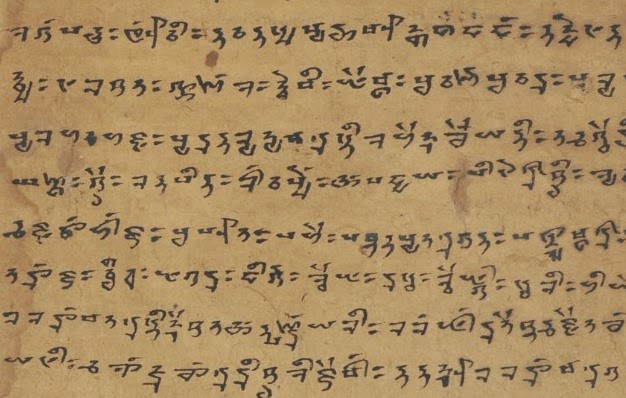
Back to phrasebooks, but staying with Khotanese, Pelliot chinois 5538 is a scroll with a series of phrases in Sanskrit and Khotanese, on the general theme of pilgrimage. Some of the phrases form conversations, like this:
And where are you going now?
I am going to China.
What business do you have in China?
I’m going to see the bodhisattva Mañjuśrī.
When are you coming back?
I’m going to China, then I’ll return.
The conversations also cover practical matters:
Do you have any provisions for the road?
I do not like my provisions.
I’ll go with one or two horses.
We don’t know whether this particular scroll (which also dates from the late 10th century) was actually used as a phrasebook – it might have just been copied out as an exercise – but most of the phrases in it are relevant to the needs of a Buddhist pilgrim travelling from India to China. The phrasebook also has some revealing snippets of conversation that suggest another interest for travellers. After some phrases regarding the arrival of a Tibetan teacher, the conversation goes in this direction:
He is dear to many women.
He goes about a lot.
He makes love.
Which suggests that gossip was another popular activity among Silk Route travellers!
* * *
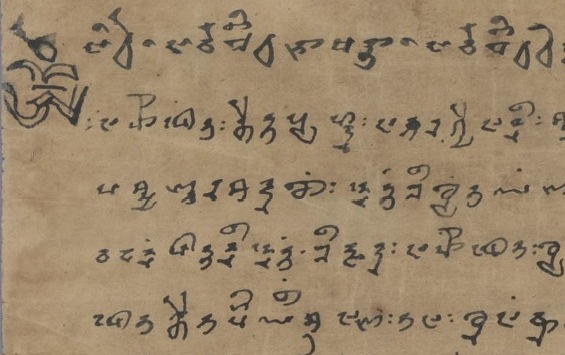
Not all Tibetan teachers were held in such low esteem by the Khotanese, as another multilingual manuscript shows (Pelliot 2782 – pictured at the top of this post). This is a letter, or a copy of a letter, written to a Tibetan lama. It’s written in the Khotanese script, as you can see in the image above, but the language turns out to be Tibetan. Presumably the writer knew Tibetan as a spoken language, but could only write the Khotanese script. Luckily for us, the Tibetan was reconstructed by Ryotai Kaneko, and published by H.W. Bailey, with an English translation. Since Bailey’s translation of the Tibetan was not very accurate, I’ve retranslated it here.
To the great teacher, the eyes of the Buddha, who sees lowly ones like us with the eyes of wisdom. Although we do not share a language, and we are not skilled in the Tibetan language of the lords of the dharma, the local rulers, please do not break your commitments. This is addressed to the great master. I respectfully enquire whether you are well, and in particular whether your precious and noble body has become fatigued. We humble ones have ridden to see the face of the Noble Mañjuśrī and are returning to [the land of] Śākya[muni], the god of gods. May we be permitted to come and make an offering to all who have seen the face of Mañjuśrī?
The letter begins with the usual polite conventions (in fact, these take up the majority of the letter) before getting to the point, a request to visit this teacher and make an offering. Like the monk whose conversations appear in the Khotanese-Sanskrit phrasebook, the writer of this letter has travelled East to visit Wutaishan, and is on his or her way back to Khotan (yes, the Khotanese did consider themselves to belong to the land of Śākyamuni).
I find something really heartening about this evidence of human beings’ ability to cross the barriers of language. OK, so maybe it was often just to buy blankets. Still I suspect that the linguistic efforts of the merchants paved the way for the communication of other things, including Buddhism. Once that has happened did the kings and emperors with their big translation projects get involved, and get the credit. That’s why its nice to have these accidentally preserved phrasebooks and multilingual lists and letters, scraps of evidence of unsung linguistic adventurers.
* * *
Further reading
Bailey, H.W. 1964. ‘Śrī Viśa Śūra and the Ta-uang’. Asia Major (New Series) 11.1: 17–26.
Bailey, H.W. 1973. “Taklamakan Miscellany.” Bulletin of the School of Oriental and African Studies 36.2: 224–227. JSTOR.
KUMAMOTO Hiroshi. 1988. ‘Saiiki ryokōsha yō Sansukuritto-Kōtango kaiwa renshūchō’ 西域旅行者用サンスクリット=コ一タン語 會話練習帳. Seinan Ajia Kenkyū 西南アジア研究 28: 53–82.
Sam van Schaik. “Red Faced Barbarians, Benign Despots and Drunken Masters: Khotan as a Mirror to Tibet.” PDF here.
van Schaik, Sam and Imre Galambos, Manuscripts and Travellers: The Sino-Tibetan Documents of a Tenth-Century Buddhist Pilgrim. Berlin: de Gruyter, 2012.
Thomas, F.W. and Giles, Lionel. 1948. ‘A Tibeto-Chinese Word-and-Phrase Book’. Bulletin of the School of Oriental and African Studies 12.2–3: 753–769. JSTOR
* * *
This is an expanded version of a post I wrote on the IDP blog.

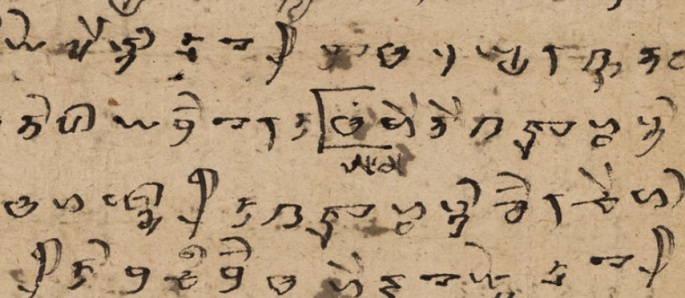
 The Bodhicaryāvatāra or “Way of the Bodhisattva” as it is often translated, is one of the most read texts in the Tibetan Buddhist tradition.* This is hardly surprising, as its author Śāntideva managed the feat of encapsulating the vast expanses of Mahāyāna Buddhism in a single elegantly and often movingly written text. What is surprising is that the text as it has been passed down in the Tibetan tradition, and as it is read in translation today, is not the earliest version, and is quite different from it. We know this largely thanks to the excellent work of Akira Saito, which is undeservedly difficult to get hold of. During the 90s Saito worked on four Dunhuang manuscripts of the Bodhicaryāvatāra, showing how the early version that they contained differed quite radically from the familiar later version. Here I’ll summarize his conclusions and add some of my own thoughts. The four manuscripts are actually three:
The Bodhicaryāvatāra or “Way of the Bodhisattva” as it is often translated, is one of the most read texts in the Tibetan Buddhist tradition.* This is hardly surprising, as its author Śāntideva managed the feat of encapsulating the vast expanses of Mahāyāna Buddhism in a single elegantly and often movingly written text. What is surprising is that the text as it has been passed down in the Tibetan tradition, and as it is read in translation today, is not the earliest version, and is quite different from it. We know this largely thanks to the excellent work of Akira Saito, which is undeservedly difficult to get hold of. During the 90s Saito worked on four Dunhuang manuscripts of the Bodhicaryāvatāra, showing how the early version that they contained differed quite radically from the familiar later version. Here I’ll summarize his conclusions and add some of my own thoughts. The four manuscripts are actually three: